And, speaking of Simnel, it is a tale related in
these parts that he was called Simnel because his father was a baker of bread.
Truth be known, we have no idea what his real name was, and some say his father
was a shoemaker or a maker of church organs instead, but he is still remembered
by the name of Lambert Simnel.
When he was about ten years old, an
Oxford-trained priest, Richard Simon (or a variant thereof, including Symonds
and Symons), took the boy under his wing and trained him in arts, manners, etiquette
and the procedures of court. Simon, with an eye on gaining the archbishopric of
Canterbury, had a scheme to pass Simnel off as Richard, Duke of York, son of
King Edward IV, and the eldest of the tragic Little Princes in the Tower (more
of whom another day), but he changed his plans and decided that Simnel bore
a passing resemblance to Edward, Earl of Warwick, a claimant to the English
throne who, it was rumoured, had recently died in the Tower of London.
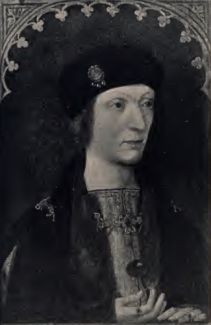 |
| King Henry VII |
During the Wars
of the Roses, there were any number of claimants to the throne, as the fortunes
of the Houses of Lancaster and York waxed and waned, and Simon was more than
likely working in connivance with the Yorkist faction of John de la Pole, the
Earl of Lincoln, who was a nephew of King Edward IV.
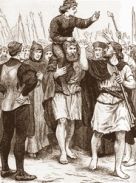 |
| Lambert Simnel carried by Sir William D'Arcy of Platten |
The Yorkists had
sympathisers in Ireland, and Simon took Simnel over the water early in 1487,
where powerful allies rallied around him and on May 24th, he was
crowned Edward VI, in Dublin Cathedral, and messages were sent to Margaret,
Duchess of Burgundy, who was sister of Edward IV and a vehement enemy of King
Henry VII, whom she regarded as a low-born Lancastrian upstart who had stolen
the crown from the House of York.
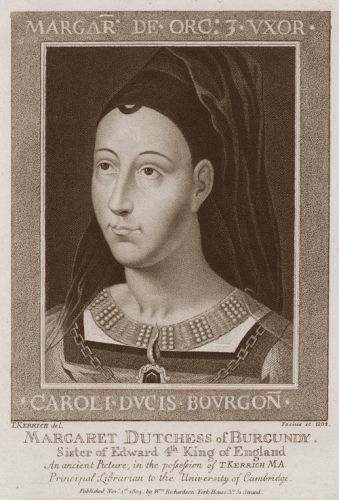 |
| Margaret, Duchess of Burgundy |
She was likely aware of the deception but
nonetheless she responded favourably and sent 2,000 German mercenaries, under
the command of a formidable captain, Martin Schwartz, who were also accompanied
by Lincoln and Lord Lovell, another prominent Yorkist.
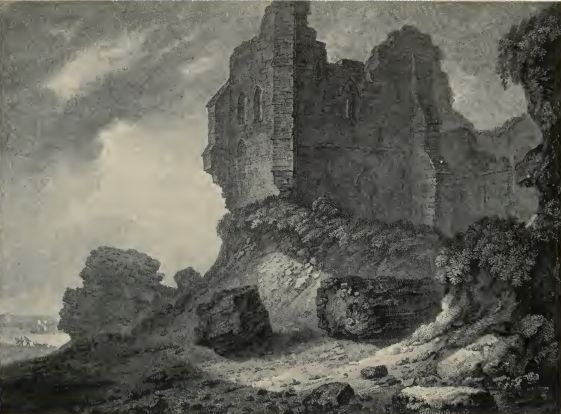 |
| Piel Castle |
In June 1487, this
force, bolstered by the Yorkist Irish and including the Earl of Kildare, sailed
for England and landed first on Piel Island, Lancashire, then called Fouldrey
or Fowdrey, and made their way to the mainland at Ulverston, at a place called,
purely by coincidence, Schwartz Moor.
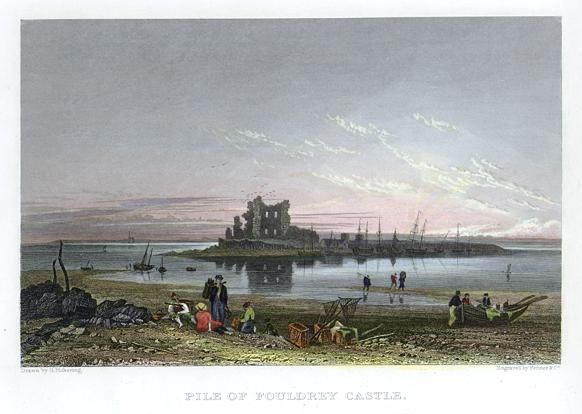 |
| The Pile of Fouldrey Castle |
Here they met Sir Thomas Broughton, a wealthy
Furness gentleman with family ties stretching back to Anglo-Saxon times, but
the expected support from the people of Lancashire was not forthcoming and so
the army headed east, over the Pennines and into Yorkshire. The forced march
covered 200 miles in five days, and the army swelled to about 8,000 men; in a
night fight on June 10th, 2,000 of them engaged a force of only 400
Lancastrians at Bramham Moor, near Tadcaster, and utterly defeated them. Lovell
then swung his army south, heading for Newark, and fighting a series of
skirmishes as they advanced through Sherwood Forest.
 |
| King Henry VII |
In the meantime, King
Henry VII, well aware of the insurrection, had imprisoned the Queen’s Mother in
a convent at Bermondsey and arranged for Warwick, who was still alive, to be
brought from the Tower to St Paul’s and publicly displayed to the population,
which really ought to have put an end to the claims of the supporters of
Lambert Simnel. Henry marched north at the head of his army, through Coventry
and Leicester to Nottingham, and unbelievably got lost on their way to Newark,
with many soldiers deserting the ranks.
They found five guides in Ratcliff-on-Trent, and
were led to the village of Stoke, (not to be confused with Stoke-on-Trent,
Staffordshire), where Henry’s army, under command of the Earl of Oxford engaged
the invasion force ranged against them on the morning of June 16th
1487. Lincoln’s troops held the strategic advantage, on a hill and surrounded
on three sides by the river Trent but inexplicably they descended and took the
fight to the King. The battle raged for three or four hours and was a particularly
bloody affair, even by the standards of the fifteenth century; the Irish were
under-armoured and ill-equipped, and were slowly but comprehensively
slaughtered. Schwartz’s German mercenaries made a determined, obstinate stand
but they too were butchered, almost to a man.
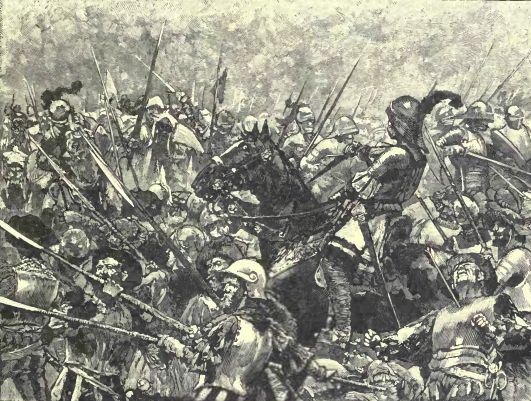 |
| The Last Stand of Schwartz and his Mercenaries |
The whole insurgent army seemed
determined to make a stand, expecting little mercy if they yielded, and over
four thousand of them were killed, together with over two thousand of the King’s
army. All of Simnel’s commanders bar one died in the Battle of Stoke Field;
Lincoln, Kildare, Schwartz, Broughton were all killed and only Lovell escaped,
seen swimming his horse across the Trent and making his way some said,
eventually, to Scotland.
Others claimed he had drowned in the Trent, and a
romantic story was told that two hundred years later, at the family house of
Minster Lovel, a secret underground chamber was discovered when a new chimney
was being built. In the room was the skeleton of a man, seated at a table, with
a mass book, paper and pen laid out, and dressed in rich, old-fashioned
clothing; as air entered the room, the skeleton slowly crumbled into dust. Was
it Lovell? We’ll never know. Is it true? We’ll never know.
 |
| Simnel and Simon before Henry VII |
The Battle of Stoke
Field was the last time Yorkist and Lancastrian armies fought each other, and
so can be called the final battle of the War of the Roses. Lambert Simnel and
Richard Simon were taken prisoner after the bloodshed, and King Henry VII
showed admirable mercy to the boy, thinking him without blame and simply led
astray by the machinations of other more devious plotters; he gave him a job as
a turn-spit in the Royal kitchens at Westminster, and through good conduct, he
was finally promoted to the position of the King’s falconer. The priest Simon
was not so lucky. He was thrown into the dungeon and forgotten about – we can
only assume he eventually died there.
 |
| Simnel the Turn-Spit |
Tomorrow - what is it with all these pretenders?
No comments:
Post a Comment